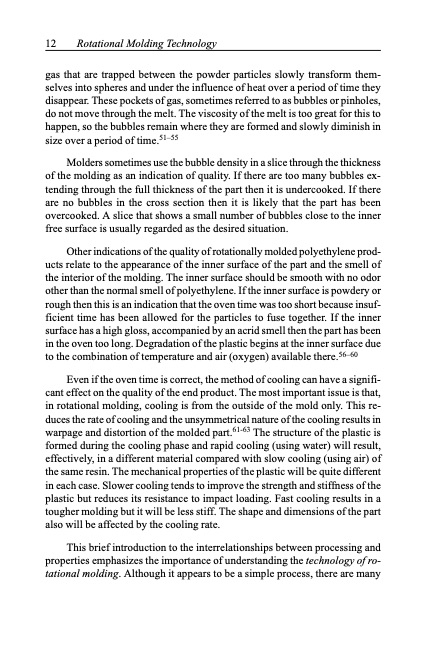
PDF Publication Title:
Text from PDF Page: 012
12 Rotational Molding Technology gas that are trapped between the powder particles slowly transform them- selves into spheres and under the influence of heat over a period of time they disappear. These pockets of gas, sometimes referred to as bubbles or pinholes, do not move through the melt. The viscosity of the melt is too great for this to happen, so the bubbles remain where they are formed and slowly diminish in size over a period of time.51ñ55 Molders sometimes use the bubble density in a slice through the thickness of the molding as an indication of quality. If there are too many bubbles ex- tending through the full thickness of the part then it is undercooked. If there are no bubbles in the cross section then it is likely that the part has been overcooked. A slice that shows a small number of bubbles close to the inner free surface is usually regarded as the desired situation. Other indications of the quality of rotationally molded polyethylene prod- ucts relate to the appearance of the inner surface of the part and the smell of the interior of the molding. The inner surface should be smooth with no odor other than the normal smell of polyethylene. If the inner surface is powdery or rough then this is an indication that the oven time was too short because insuf- ficient time has been allowed for the particles to fuse together. If the inner surface has a high gloss, accompanied by an acrid smell then the part has been in the oven too long. Degradation of the plastic begins at the inner surface due to the combination of temperature and air (oxygen) available there.56ñ60 Even if the oven time is correct, the method of cooling can have a signifi- cant effect on the quality of the end product. The most important issue is that, in rotational molding, cooling is from the outside of the mold only. This re- duces the rate of cooling and the unsymmetrical nature of the cooling results in warpage and distortion of the molded part.61-63 The structure of the plastic is formed during the cooling phase and rapid cooling (using water) will result, effectively, in a different material compared with slow cooling (using air) of the same resin. The mechanical properties of the plastic will be quite different in each case. Slower cooling tends to improve the strength and stiffness of the plastic but reduces its resistance to impact loading. Fast cooling results in a tougher molding but it will be less stiff. The shape and dimensions of the part also will be affected by the cooling rate. This brief introduction to the interrelationships between processing and properties emphasizes the importance of understanding the technology of ro- tational molding. Although it appears to be a simple process, there are manyPDF Image | INTRODUCTION TO ROTATIONAL MOLDING 1

PDF Search Title:
INTRODUCTION TO ROTATIONAL MOLDING 1Original File Name Searched:
Introduction-To-Rotational-Moulding.pdfDIY PDF Search: Google It | Yahoo | Bing
Development of a solar powered Electric Ship The Electricship website originally started off as a project to develop a comprehensive renewable, affordable, modular electric ship... More Info
Modular Boat Hull Composite The case for a unsinkable, modular composite hybrid boat hull... More Info
MS Burgenstock Hybrid Electric Catamaran Lake Lucerne Unique shuttle servicing Lucerne to the Burgenstock Resort... More Info
Ground Power Unit GPU Powered by Lithium Ion Batteries The goal of the Ground Power Unit is to provide a readily accessible, modular, ready-to-power solution for remote power... More Info
| CONTACT TEL: 608-238-6001 Email: greg@electricship.com | RSS | AMP |